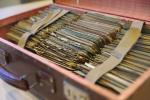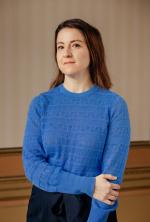
‘I see you are still alive’ - The Unopened Letter and the Digital War Letters Collection of the University of Luxembourg
In February 2021, a research team, consisting of Sarah Maya Vercruysse and Nina Janz at the Luxembourg Centre for Contemporary and Digital History (C2DH) at the University of Luxembourg launched a call for contributions as part of the project, "WARLUX – War Experiences in Luxembourg", funded by the Luxembourgish Research Fund (Fond National de la Recherche). The WARLUX project at the University of Luxembourg aims to collect personal war experiences of men and women who were drafted into Labour service (Reichsarbeitsdienst, RAD) and/or military service in the Wehrmacht by the Nazi occupation administration during World War II in Luxembourg.
A new unique digital archive
To uncover the individual experiences of these men, women and families, the team asked the public to share their family stories, letters, diaries, photographs, and other personal documents. The researchers Sarah Maya and Nina aimed to enrich existing records of individual experiences which had not yet been collected or published. While the crowdsourcing campaign was intended to collect complementary research material, we created a unique digital archive of personal memories and individual voices in the form of first-hand documents, containing in total 5000 letters and around 20 diaries, a novelty in the cultural landscape in the Grand-Duchy of Luxembourg.
The documents were scanned on campus using a high-performance scanner and a paper-saving process. In a second step, the digital copies of the letters were stored and indexed. To ensure readability and capture the content, the WARLUX team uses software for Handwritten Text Recognition (HTR) such as Transkribus by READ COOP, to transcribe the letters. The documents are mainly written in German, but also in French and Luxembourgish. While Language Models for the HTR process can be already used in Transkribus, a Language Model for Luxembourgish does not exist (yet). Within the project WARLUX, the team is training an own language and HTR model for the war letters and works also on a first Luxembourgish Model.
A suitcase full of letters
Among the crowdsourced material, a suitcase containing over 2000 letters from various senders, primarily from the Hirt brothers, was brought to campus (see Image 1). During the scan process, an unopened letter from November 1943 was discovered among the letters in the suitcase. Although all the other letters have been opened and can be read, this particular letter remained sealed.
The letters we hold in our hand were written by Jean-Pierre Hirt, a native of Ettelbrueck in the North of Luxembourg, who was born in 1923. Jean-Pierre's story is one of many in Luxembourg who were forced to serve in the German military during World War II. Initially, he was drafted into the Labour Service (RAD) before later being transferred to the Wehrmacht. Alongside his elder brother Michel (born 1920), Jean-Pierre was stationed in the air force and trained as a radio and telecommunications operator. The two men who were forced to wear the German uniform wrote hundreds of letters and postcards to each other even during their unlawful military service.

The suitcase containing their letters (mainly from Jean-Pierre) shows a rich correspondence with their family members and friends from all over Luxembourg. A friend of Jean-Pierre and Michel was Aloys Michels (born 1921), a friend from the town of Ettelbrueck. Aloys was also drafted by the Nazis and detached for service on the Eastern Front. While the brothers Jean-Pierre and Michel were trained in radio and telecommunications in northern Germany, Aloys fought in Ukraine at the beginning of the winter. The field post service enabled communication between the front and home.
Nevertheless, it was associated with many difficulties: Letters had to overcome German censorship – the Luxembourgish men (and women) had to write to their relatives in German. They were not allowed to reveal any information about their position or their military activities. Many letters did not arrive, were lost, or parcels containing food and goods such as warm clothing and luxury items like razors or soap were stolen. Many letters, therefore, did not arrive at their destination.
.jpg?itok=tteEgUg4)
Jean-Pierre and Michel frequently used the field post service to correspond with family and friends. On 1 November 1943, Jean-Pierre and Michel were at the training station in Nordhausen as they wrote to their friend Aloys. The letter begins very unusually with “I see you are still alive and in good spirits”. This sentence in the letter makes it clear that it was written during a war, where survival is uncertain. It depicts the life-threatening danger of war, with loved ones anxiously awaiting any news or message from those at the front. The tragic setting continues. In large letters Zurück (to return, Image 2), the letter sent arrived back at the brothers in Nordhausen. This means Aloys had never received, nor read the letter.
The last news about Aloys comes from the grave registration of the German War Graves Commission (Volksbund Deutsche Kriegsgräberfürsorge): Aloys was reported missing or dead on 1 November 1943, the same day Jean-Pierre wrote the letter to his friend, hoping that Aloys was still alive. It is not clear when Aloys died; either he was captured by the Red Army or mortally wounded. This small moment in a young man’s life during the war is certainly not the only one. Hundreds in Luxembourg and others in Europe, Australia, Japan and the USA experienced similar situations – many letters returned to the sender because the intended recipient died. The brothers both survived the war and returned to Ettelbruek. Jean-Pierre probably took the letter with him to Luxembourg and kept this document in a suitcase with other letters for decades, before the letter was discovered and opened by the WARLUX team.
Starting in September 2023, Nina will pursue her research with an HORIZON.1.2 - Marie Skłodowska-Curie Actions postdoctoral fellowship at NIOD, where she will focus on the war experiences of non-German soldiers, specifically Dutch, Belgian, and Luxembourgish conscripts and volunteers, from a transnational perspective
This blog was written by Dr. Nina Janz.
